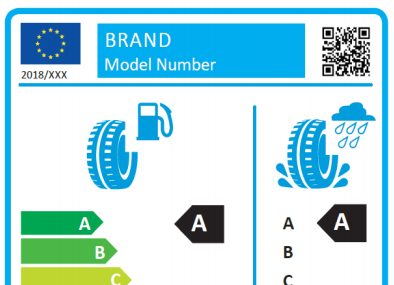ETRMA targets early 2020 for new EU Tyre Labelling Regulation
 The proposed new label adds snow performance, ice grip and a QR code to the previous design
The proposed new label adds snow performance, ice grip and a QR code to the previous design
The European Tyre & Rubber Manufacturers’ Association (ETRMA) is ready to enter the final phase of the review on the 2009 EU Tyre Labelling Regulation, following the outcome of the European Parliament plenary vote to replace the existing regulation. The association said that “an improved Regulation” could be adopted in early 2020, should the new European Parliament move the file into trilogues in the second half of 2019. ETRMA added that it is pleased with the commitment and efforts by the European Institutions to pursue a new Tyre Labelling Regulation, as it “increases consumer awareness of the label and strengthens market surveillance and enforcement in EU Member States.”
ETRMA secretary general, Fazilet Cinaralp said: “This is a positive step taken by the European Parliament towards an ambitious, forward-looking Tyre Labelling Regulation. The European tyre industry already today offers high performance tyres made available to consumers and vehicle manufacturers, and the tyre label is there to inform consumers.”
For the trilogue negotiations going forward, ETRMA and the European tyre industry call upon the European Institutions to remain focused on the central objectives of the Tyre Labelling Regulation:
- Raise consumer awareness of the tyre label and rolling resistance, wet grip and noise performances;
- Include Snow or Ice logo on the label, when applicable;
- Reinforce the visibility of the Tyre Label at both physical and online purchases;
- Incentivise a market uptake of high performance tyres in the general interest of road and passenger safety and the environment;
- Improve enforcement and market surveillance; and
- Establish a publicly available product database and include a QR code on the label.
ETRMA reiterated two important points it would like to be taken into consideration during trilogues:
“Rescaling of the tyre label performance classes is premature. Rescaling of single performances would result into a flattening of the current label information downwards and be counter-productive. Increased market penetration of higher-class tyres must be sought and incentivised through other means, for example public procurement initiatives and development of customer awareness.”
Cinaralp added: “To explore the full potential of the existing tyre technology strong incentives must be promoted to assist the necessary market uptake. The tyre label is an important instrument to inform consumers on the performance of the individual tyre, but currently lacks visibility and consumer awareness.”
ETRMA states that industry is currently assessing the feasibility of a standard test method for tyre tread abrasion. It adds that the European tyre industry is working towards assessing the feasibility of a reliable and representative test method for measuring tyre tread abrasion and supports the Commission’s call for a reliable test method for tyre tread abrasion rate. With this in mind ETRMA contends that “the inclusion of tyre abrasion based on a standard test method would require a full revision of the Regulation and cannot be carried out via delegated act, as proposed by the Commission. The process is still in its infancy and needs to be completed before any measure can be introduced in this – or other – Regulations.”
On a standard test method for tyre abrasion, Cinaralp concluded: “The European tyre industry is fully engaged in the environmental challenges of tyres including the need for development of a reliable test method to measure abrasion performances, a work already initiated by the industry. Our ambitions are high and we remain devoted to provide technical solutions for the changes in environmental and societal needs.”




Comments